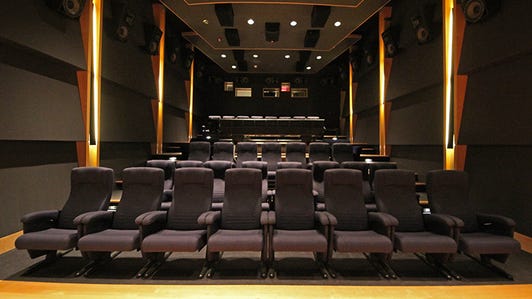
Dolby
With any luck you’ve at least heard about the latest surround-sound standard, Dolby Atmos. Maybe you’ve even had a chance to hear it, in one of the 650 theaters so equipped. It’s a different way to do movie surround sound, not just with additional speakers, but changing the way movie sound is mixed and adding a new dimension — literally — to the sound.
Now, it’s headed to your home. We head to sunny Burbank, in Los Angeles, to take a listen.
Dolby Atmos at home (pictures)






Atmos in the theater
Movie sound, until recently, has been mixed very similarly for the cinema to the way you hear it at home. There were a certain number of channels, and those channels were sent to specific speakers. In your home, a 5.1 mix might send a surround-sound effect to a rear speaker. In the theater, that same sound might have been sent to an array of speakers. The idea was the same: sound > speaker channel. The array (multiple speakers) was necessary, given the size of the theater and the number of ears therein.
Atmos changes that, adding the ability to individually address all of the speakers in a theater — or at least, many more of them. So, for example, instead of a sound occurring somewhere over your shoulder, the sound designer can place it precisely at your 8 o’clock. Even better, sweeps of sound (a helicopter flying around, say) can be far smoother, passing from speaker to speaker instead of from array to array.
The result is a far more seamless surround effect. It’s less like you’re listening to individual speakers in a room, and more just being surrounded by sound. This, of course, is exactly what the promise of surround sound was supposed to be from the start.
In addition, Atmos adds height speakers, but unlike Dolby Pro Logic IIz, they are designed to appear discretely in the mix and not be simply “matrixed” from the front channels. More than just adding a new way for sounds to “whoosh” overhead, the height speakers add a dimension to the sound (obviously) that you didn’t notice was missing. Instead of sounds occurring in a flat disc around your head, they’re able to have height, even if the sound isn’t specifically coming out of the height speakers. It adds a fullness, a hemisphere of sound, if you will.
Atmos is able to add so many more channels by doing away with the “channel” concept altogether. Instead of “this sound to rear-right speaker,” the sound designer tells the Atmos software to place the sound “object” in a specific area, like “rear corner, halfway up the wall.”
The Atmos decoder at the theater, knowing what speakers it has to work with and where they are, interprets the location metadata in the Atmos feed, and places the sound exactly where the sound designer intended, regardless of the number of speakers in the theater, or their placement (within reason, of course). The Atmos system can support up to 128 of these different sound objects in any one scene at a time.
In the home
When Atmos was first announced, everyone assumed it would make it into the home. Smartly, Dolby has waited to take that step until there were more Atmos movies (there are 150 so far), and so that more people have had a chance to experience the system in the theater.
The way Dolby is implementing Atmos for the home is both smart and elegant. While you will need a new receiver with Atmos decoding, and also additional speakers (more on this later), you won’t need a new Blu-ray player, you won’t need different cables, and best of all, the Blu-ray discs themselves aren’t changing.
The Atmos metadata works within the current Blu-ray and HDMI spec (even HDMI 1.4, not even 2.0). The Atmos layer sits on top of the existing 5.1 mix and is activated only once it detects a compatible decoder.
It’s completely backward-compatible too. So you can buy a Blu-ray movie that has Atmos on it, and if your current gear isn’t Atmos-compatible, your gear will just treat it like any other disc. If your gear is Atmos-compatible, it will see the additional information and give you Atmos in your home.
Here’s the really cool part. Because Atmos in the theater is “object” based, where objects of sound are placed in an area, not to a specific speaker, Atmos at home ends up working basically the same way. You tell your new receiver what speakers you have and where they are (and answer a few other questions), and your receiver will build you a custom surround mix based on your gear and your room.
Related Stories
- Dolby to put Atmos surround sound on tablets, smartphones
- Dolby adds a new dimension to sound
- Dolby Atmos is coming to home theaters via Pioneer, Denon, and more
- LED LCD vs. plasma vs. LCD
- HDMI vs. DisplayPort vs. DVI vs. VGA
The gear
With all this new decoding and processing, it shouldn’t surprise that you’d need a new receiver. Since many new receivers are already shipping with Atmos (or will be firmware-upgradable soon ), it’s highly likely that your next receiver will have Atmos built in anyway.
But it’s the new speakers that gave you pause, right? Speakers…on the ceiling. I’m positive many of you stopped reading right there. Adding more speakers to a room isn’t high on many people’s priorities. The solution is actually why I’m rather optimistic about Atmos at home.
You can add speakers to your ceiling if you want, but even Dolby knows most people aren’t going to do this. Instead, they came up with processing that allows upward-firing drivers in regular floor-standing (or stand-mounted) speakers to bounce sound off the ceiling and seem, to your ear, like the sound is coming from the ceiling. Check out the gallery above to see what these look like.
How does it all sound? Good question…
Ears on
Dolby recently had an event at its facilities in Burbank, Calif., where several clips were played in a Dolby Atmos theater (where many Atmos mixes are actually created), and then again later in a home-theater environment. Pictures of both are in the gallery above.
In this home theater, there were four ceiling-mounted speakers. Additionally, the main speakers had upward-firing drivers. We were given a chance to listen to the system in “traditional” 7.1 speaker mode, a “normal” Atmos setup with ceiling speakers, and then again with the upward-firing drivers in the floor speakers.
It was impressive, in the demos we heard at least, how successfully the “dome of sound” aspect of Atmos successfully translates to the smaller space with smaller speakers. During the demo, they switched between the normal 7.1 setup (sans ceiling speakers) and the “7.1.4” setup adding in the four ceiling speakers. The 7.1 sounded good, but definitely seemed like a plane of sound centered roughly around your head. The height speakers made the sound surround you more, envelop you, more like sound does in the real world.
Perhaps most interesting was the switch to the upward-firing drivers. They did make sound that seemed to come from the ceiling. Was it as perfect as the actual ceiling speakers? No, but it was very, very close. The most noticeable difference was with the different timbre of the upward-firing drivers, but that could easily have been due to the nonproduction samples used in the demo. We’ll have to wait and see — or rather, wait and hear — what the real speakers sound like. Even so, I’m optimistic it Atmos will work in the home.
Bottom line
When I first heard about Atmos, I figured it was another version of the interesting-but-not-loved ProLogic IIz. Height channels, again? Really? The more I learned about it, the more impressed I was. The movement away from channels is fascinating, and the result in the theater is undeniably cool. In fact, every movie I’ve seen in the theater since it was released, I’ve chosen to see with Atmos (my local theater even has 2D Atmos showings that use the 3D projector, so they’re bright too).
Atmos in the home I’m tentatively excited about as well. The translation into the home space, including the use of some clever speaker design, has promise. Is it for everyone? Of course not. Will there be a rush of people buying ceiling, or even upward-firing, speakers and a new receiver? I’m sure there will be a few.
The beauty of Atmos is it can stealthily be in your new gear, and when you want to upgrade for it all to work together, you can. Perhaps even better than that, if you want to add more speakers to make the sound even more seamless (adding, say, additional height speakers, more rear speakers, whatever) all you need to do is tell the Atmos decoder, and it will create a new mix based on your new gear. It can go from 2.0 to the current max of 24.1.10, and anywhere in between. (Yes, that’s 24 speakers, a subwoofer, and 10 ceiling speakers.)
It’s not even disruptive on the software front, with discs that will work with current players. There isn’t even a change on the streaming front. Atmos can work via any current streaming service that uses Dolby Digital Plus.
How soon? One website even has a theory that there are discs on the market already that have Atmos on them.
I enjoy surround sound, but for many years, I was quite content with two excellent stereo speakers and a sub. I have 5.1 in my theater now, and after hearing the home demo at Dolby, I’m seriously considering adding some ceiling speakers. It’s such an enveloping, rich surround experience that even as jaded as I am, I’m impressed by it and am looking forward to hearing more.
Got a question for Geoff? First, check out all the other articles he’s written on topics like why all HDMI cables are the same, LED LCD vs. plasma, active versus passive 3D, and more. Still have a question?Send him an e-mail! He won’t tell you what TV to buy, but he might use your letter in a future article. You can also send him a message on Twitter @TechWriterGeoff or Google+.




